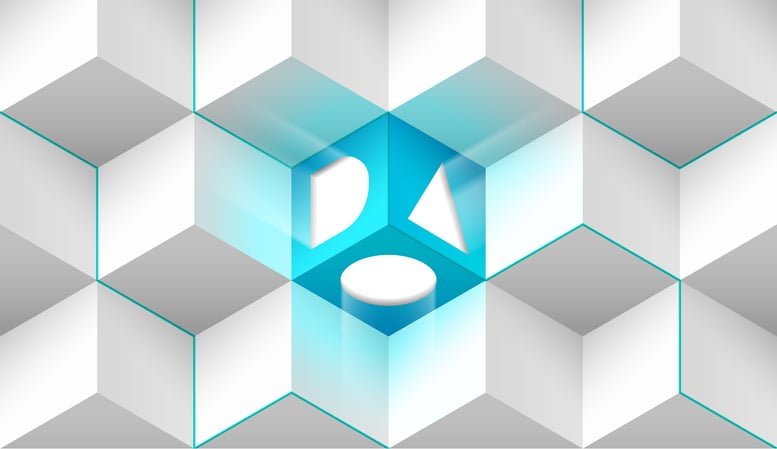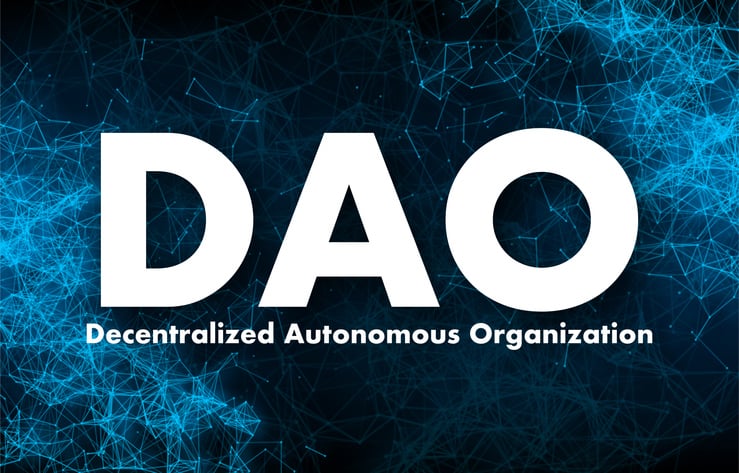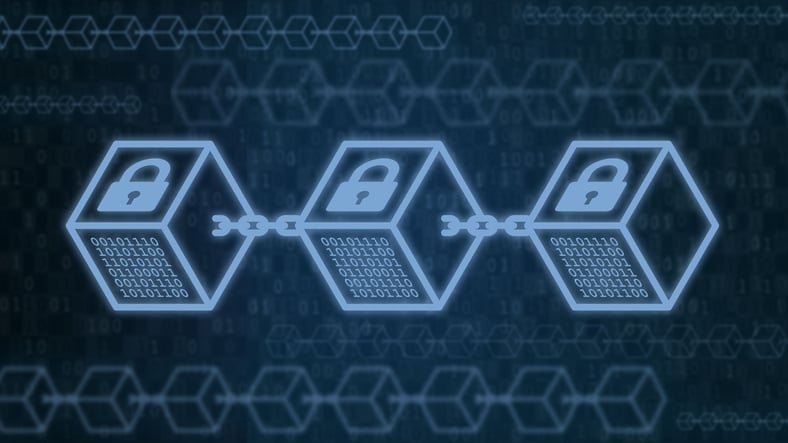
The workplace continues to transform in our not-so-post-pandemic world. Tens of millions of workers have migrated into the home and support for labor unions is the highest it’s been in decades.
The next spin of the wheel aims to eliminate the very idea of traditional employment altogether and replace it with Decentralized Autonomous Organizations, or DAOs.
This techno-utopian vision of communally run businesses that exist entirely online has taken the financial technology sector by storm in recent years, and it may soon be coming to a construction company near you.
By now, you’re probably wondering: What the heck is a DAO? And why should I care?
If you watched the Superbowl this year, you’ve already encountered one in the form of a mystifying ad featuring pixelated blue spectacles and a gigantic guitarist glittering in the virtual moonlight — the result of a partnership between Budweiser and a decentralized autonomous organization called Nouns DAO.
In their short lifespans, DAOs have experienced both explosive growth and catastrophic failures, espousing admirable ideals of equality on paper yet often falling woefully short when the rubber meets the road. At their best, DAOs represent an exciting alternative to traditional forms of human organization. At their worst, they’re pyramid schemes.
So, what is a DAO? And should the construction industry embrace or flee from this latest workplace innovation?
Let’s dive in.
Jump Ahead:
- What is a DAO?
- DAO "Smart Contracts"
- Blockchain explained
- DAO Statistics
- DAOs in the architecture, engineering, and construction industry
- The problem with DAO
- Are DAOs a good idea for the construction industry?
DAO Meaning: What is a Decentralized Autonomous Organization?
According to Etherium, the creator of the first DAO, a decentralized autonomous organization is “a collectively-owned, blockchain-governed organization working towards a shared mission.”

There are many reasons to start a DAO, but the main purpose is to open up a space online where people from around the world can collaborate and build consensus without the need for oversight by a CEO or managers. This is the enticing alternative to the traditional top-down hierarchy that DAOs represent: a promise of equal voice and decision-making power shared among all members of a workplace.
DAO Smart Contracts
In a DAO, the rules are encoded as “smart contracts:” automated terms of agreement that are specific to blockchain software. Often getting their starts in existing online communities, many DAOs coordinate their actions over apps like Discord or Twitter, and kickstart their funding by minting their own membership tokens: crypto-backed digital assets with monetary value that participants use to make proposals and cast votes about what courses of actions to pursue within the DAO.
Blockchain explained
This is a good place to hit pause for a moment and explain the technology that forms the foundation of DAOs.

If you’re already familiar, feel free to skip ahead. For those who aren’t familiar, blockchain is a unique type of open-source software that allows users to share, store, organize, secure, and authenticate information online independent of a centralized authority.
Here’s the short version of how it works:
Think about cloud-based applications like Google Drive, where multiple visitors can create, view, and interact with files online — or, closer to home, a cloud-based inventory app, which offers real-time visibility to assets on any device, limitless documentation and service records, streamlined ops, a multi-user collaboration (as well as customizable permission levels for enhanced security), etc.
Blockchain is kind of like that, but unlike the cloud, it’s not managed or owned by a single entity. Blockchain is not stored on remote servers, that is. Instead, the blockchain exists solely on the computers and mobile devices of its users in the form of peer-to-peer networks called “nodes.” This decentralized framework, along with the anonymity it provides, has made blockchain an ideal tool for creating cryptocurrencies and non-fungible tokens (NFTs), the two speculative financial schemes that are the technology’s most notorious progeny.
The decentralized nature of blockchain technology is also what makes DAOs possible. On the blockchain, records of any and all transactions are verified by consensus and are plainly visible in real-time to all parties who use the software. In theory, this “trustless” structure makes blockchain–and DAOs by extension–exceedingly difficult to tamper with, since any falsification will sound alarms up and down the chain.
At least that’s how it’s supposed to work.
In reality, blockchains are much less impervious to cyberattacks and abuse than their proponents would have you believe, as evidenced by the recent collapse of the FTX crypto-exchange, which lost investors billions of dollars overnight and resulted in the arrest of founder Sam Bankman Fried for financial fraud.
DAO Statistics
Back to DAOs.
Are decentralized autonomous organizations the business structures of the future?
This is a headline that appeared on the World Economic Forum’s website this past June. The article posited that DAOs might be the fundamental building blocks of something called Web3, a theoretical concept of a future internet that would run on a hybrid of blockchain and virtual reality technology.
The WEF expanded on the topic in a white paper that opened with some eyebrow-raising statistics: In 2021, DAO treasuries had ballooned from $400 million to $16 billion. In as much time, the number of DAO participants exploded from 13,000 to 1.6 million people around the globe.
These numbers come from an analytics firm called DeepDAO, which acts as a sort of real-time gauge of DAO activity. Like bubbles in a very expensive glass of champagne, DAOs have proliferated at a rapid rate since the first one was uncorked in 2016. As of this writing, there are more than 10,000 DAOs in existence, with a total treasury of $9.5 billion between them (the amount fluctuates up and down with the value of the cryptocurrencies in their coffers).
Ethereum, the WEF, and other proponents of DAOs often argue that decentralized autonomous organizations can be used by a diverse array of groups for a variety of different missions. However, the overwhelming majority of DAOs currently in existence are related solely to cryptocurrencies, NFTs, decentralized finance (DeFi) ,and other inward facing, blockchain specific uses.
There are outliers, including the now defunct ConstitutionDAO, which was organized around the shared mission of purchasing a copy of the US Constitution. Another now dissolved group, SpiceDAO, raised a whopping $3 million to purchase a rare copy of a book containing filmmaker Alejandro Jodorowsky’s legendary plans for his lost adaptation of Frank Herbert’s “Dune.” Decentraland is a virtual online gaming space owned and operated by a DAO. UkraineDAO, meanwhile, has raised $7 million in donations to support the Ukrainian people during the ongoing Russian invasion.
But these are the exceptions to the rule, and even they are built on the logic of crypto-finance, with members voting and trading in tokens and NFTs.
Today, the five largest DAOs are Uniswap, an Ethereum based cryptocurrency exchange, valued at $2.5 billion; BitDAQ, a Peter Thiel supported crypto-exchange, valued at $1.7 billion; ENS, “a decentralized naming service” for crypto-wallets; valued at $1 billion; Gnosis, a DAO creation platform, valued at $673 million; and OlympusDAO, a decentralized finance platform (and probable Ponzi Scheme), valued at $209 million.
DAOs in the architecture, engineering, and construction industry
Though still rare, DAOs have begun to sprout up in the AEC industry.
“While most DAOs have focused on decentralised finance or similar endeavours, very few DAOs have emerged that seek to produce material artefacts such as buildings.”
So reads a line from a white paper by ArchiDAO, a group that claims to be the world’s first decentralized autonomous organization created by and for architects.
Registered in the Czech Republic as a domain in November of 2021, ArchiDAO envisions using smart contracts and NFTs to foster “collective authorship” of architecture in both the physical and virtual worlds. One of the projects listed on its website is to create a “crypto twin” of the first Czech 3D printed building that will exist as a collection of NFTs within the metaverse.
ArchiDAO believes the AEC industry is fertile ground for DAOs, and it isn’t alone in this thinking. Global consultancy firm Ey-Parthenon envisions a future where buildings own and operate themselves via DAOs. As fantastical as the idea might sound, it is already taking shape in the real world in the form of no1s1, a prototype of a “self-owned home on the blockchain” created by Swiss public research university ETH Zurich.
DAOs have been proposed for everything from incentivizing decarbonization to overhauling construction supply chains, and improving project management. A 2020 paper in the International Journal of Architecture Computing imagines combining DAOs with Building Information Modeling (BIM) to revolutionize how buildings are designed and operated in the 21st Century.
If you’re a construction professional, you might someday find yourself employed within a DAO, or with a DAO as your client, working on a project owned, proposed, and voted on by its members.
And that day may come sooner than you think. In November, after raising $6 million from the sale of membership tokens to 5,000 people online, CityDAO turned around and purchased 40 acres of land near Cody, Wyoming. The group accomplished this by taking advantage of a recently passed Wyoming law that grants legal status to DAOs, the only such law currently on the books in the US.
While discussing what the land might be used for, founder Scott Fistimone suggested at a recent TED Talk that CityDAO might someday “build the next great city.”
What Are the Inherent Problems, Risks, and Challenges of DAOs?
For all the buzz surrounding them, DAOs also have some glaring red flags
For starters, many DAOs aren’t actually as equal and democratic as the rosy picture painted by enthusiasts.
Remember those membership tokens, the cryptocurrencies that DAO participants use to vote on proposals? In many DAOs, voting power is determined by the number of tokens you have, and tokens aren’t given away freely–they have to be purchased. This gives wealthier members a leg up when it comes time to make decisions within the DAO.
Here’s an excerpt from that WEF white paper from earlier:
“While some [DAOs] result in broad representation through collective decision-making, others risk recreating quasi-oligarchic dynamics by concentrating governance tokens in the hands of a small number of powerful players like venture capitalists and early insiders.”
The monetary value of membership tokens can also incentivize corruption from within, as in the case of MetaDAO, who’s members were robbed of $3.2 million in a rug pull scam run by the group’s founders.
DAO’s also suffer from a lack of accountability and transparency. In many DAOs, participants are allowed to be anonymous, which opens the door to potential abuses at high levels of power. An example of this comes from Wonderland DAO, whose pseudonymous treasurer “OxSifu” was recently revealed to be convicted felon Michael Patryn, the co-founder of Quadriga, a Canadian crypto exchange that defrauded investors of $190 million.
Which brings us to the biggest problem with DAOs. Hacks, scams, fraud, and crashes now appear to be the rules rather than the exceptions, features rather than bugs in the cryptocurrency-obsessed blockchain world.
An exhaustive chronicling of the many systematic failures of crypto-finance can be found on software engineer Molly White’s blog, web3isgoinggreat.com. The implosion and fallout of FTX is only the latest example. The pattern extends all the way back to the collapse of the Mt. Gox crypto exchange in 2014, which investors have claimed lost them a staggering $2.4 trillion.
This volatile cycle has replicated itself in the world of DAOs.
Created by Ethereum in 2016, the world’s very first DAO was dismantled shortly after its launch when a hacker stole $50 million of Ether (worth billions today), the membership token that the DAO ran on. Other examples of DAO snafus in more recent years include a class-action lawsuit alleging fraud by Uniswap, the world’s largest DAO; another lawsuit against the founders of Ooki DAO; BadgerDAO’s loss of roughly $120 million to cyber attackers; the $470,000 collapse of BuildFinance DAO; the financial mismanagement of PadawanDAO; and a $92,000 Discord hack of CityDAO, the group that hopes to someday build a “city of the future” in Wyoming.
Cases like these have put DAOs on shaky legal ground, as evidenced by the Security Exchange Commission’s recent crackdown on American CryptoFed DAO, making DAOs a tough sell for serious organizations looking to stay above-board with regulators.
Are DAOs a good idea for the construction industry?
While there are some potential use cases for the AEC industry, there are also–for now at least–plenty of very good reasons to run in the opposite direction of DAOs.
Traditional companies are far from perfect and DAOs undeniably open the imagination to other exciting possibilities: Democratic self-governance, the flattening of hierarchies, sharing power equally among peers–these are all appealing aspects of what DAOs have to offer.
But as we’ve seen, DAOs often end up replicating the very top-down hierarchies they claim to disavow. They also remain vulnerable to the same risks of abuse that plague the cryptocurrencies their token systems are built upon.
Before diving head first into a DAO, professionals in the AEC industry would be wise to ask themselves a series of questions: What do you hope to accomplish with a DAO that you can’t accomplish with other forms of organization? What about DAOs appeals to you most? Is it the ideal of a decentralized form of self-management? Or the possibility of making money from the sale of membership tokens?
If you’re drawn to the ideal of egalitarianism, take a moment to consider other options like worker-owned cooperatives. Time and battle tested since 1956, the massively successful Mondragon Corporation in Spain is a prime example of what worker co-ops are capable of. Organized into 95 autonomous collectives, Mondragon’s 80,000 employees, 76 percent of whom work in manufacturing, routinely vote together on decisions about strategy, salaries, and policy; all without the need for blockchain or crypto-tokens.
If instead you’re attracted to the financial aspects of DAOs, it’s important that you educate yourself on how blockchains and cryptocurrencies work in order to make informed decisions about the potential risks that lie ahead. Beef up on cybersecurity and consider hiring a construction technologist to advise you along the way (for heightened security, look into creating a private DAO on a “permissioned” blockchain). The potential freedoms granted by DAOs are important, but so is accountability, so make sure there are external checks and balances in place to ensure everything is above board. Finally, consider replacing the monetized token system with a less problematic method of participation. There are already glimmers of alternatives, such as SuperteamDAO’s reputation based membership system, which awards points in exchange for desirable actions.
Bottom Line
The workplaces of tomorrow will likely look very different from how they do today.
The Decentralized Autonomous Organization offers one possible blueprint, but it is not the only or even the best design for building more equality into our organizations.
While flawed, DAOs are still a young and growing concept, and it’s possible that they may improve over time. How they are used and what effects they will ultimately have on the AEC industry remains to be seen.